|
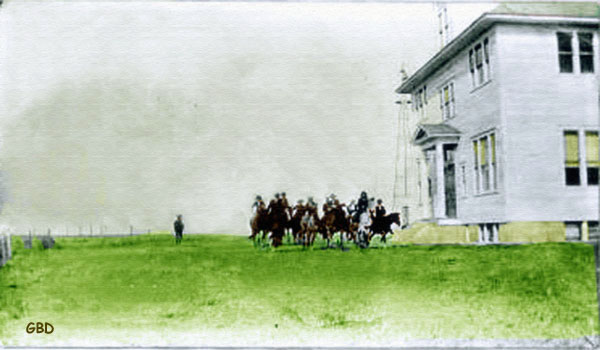
Students arriving at Wilkinson Hall, Jireh College, artwork based on
photo.
Wilkinson Hall was named in honor of Levi J. Wilkinson (1825-1914), a Cynthiana, Indiana, pilanthropist. Wilkinson donated to the College
some 62 acres of land as well as $5,200 used to establish the college.
Between Manville and Keeline are the remants of Jireh College which operated from 1909 until 1920. The boys' dormatory in the main building depicted above
was on the top floor, girls'
dormatory and house mother's quarters were on the second floor, and the dining room and kitchen were in the
basement. Congressman Frank Mondell was the priniple speaker at the laying of the
cornerstone. The School originally intended to open at the beginning of 1910, but the Hall was not yet ready. A few students
were given classes and recitations in the Church. The first regular term was a summer term opening on
July 18, 1910 with four students and two instructors. The initial president of the college was the Reverend George C. Enders who devoted most of his
attention to financial matters. He was succeeded the following year by the Reverend William Flammer.
The following year, Dr. Daniel B. Adkinson (B.D., M.A. D.D. University of Chicago) was appointed who remained except for a brief period when he took a leave of absence for health.
Ultimately a separate dormatory was constructed for the girls.
Tuition was $65.00 including room and board. $65.00 in 1913 is equal to $1553.43 in 2015. The College was a small school affiliated with the Christian Church, now a part of of the United Church of
Christ. The college offered four years of high school and a two-year junior college.
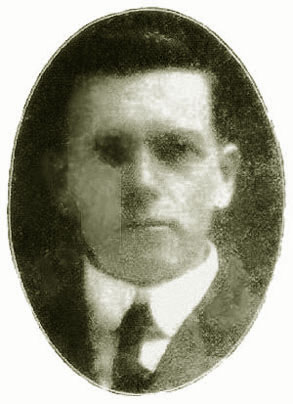
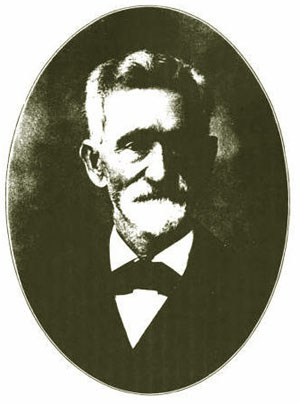 Left: Daniel B. Adkinson Right: Levi J. Wilkinson
Nearby was The town of Jireh founded at the same time as the College. The town at one time
had two banks, a lumber yard, post office, store, express office, three general stores, a rooming house, hotel, blacksmith and newspaper. The newspaper,
Jireh Record published from 1913 until January 1914. Two-Thirds of the front page of its fist two edicitons
were taken up with announcements of the opening for sale of state-owned school lands. Three months after the paper's last
issue in 1914, it was replaceced by the
Jireh Tribune managed by Daniel B. Adkinson (1869-1933). Dr. Adkinson was President of the
College. The post office served smaller towns further to the south as far away as Flattop at first on a two-day a week basis later
deliveries to the south were later on Mondays, Wednesdays, and Saturdays. Additionally,
a dry farming experimental farm grew sugar beets, wheat, potatoes, and alfalfa. The college was intended to provide
a liberal arts education to the children of settlers in the area and actively supported the
dry-farming movement including hosting of meetings and symposia on the subject. One such meeting was attended by
Governor Carey.
In 1916, Dr. Adkinson writing in the
Christian Annual 1917 p. 33 noted:
Jireh College was founded for the purpose of giving a Christian education
to the boys and girls of the last great American frontier. On the ranches and
farms and in the small towns of the West, there are many young people who do
not have high school privileges within their reach. They must go away from
their homes for these advantages. Jireh College offers these boys and girls a
high school education and two years of college work under Christian influences
at a reasonable cost. Many students come from communities that do not have
religious privileges. The college is a messenger of Jesus Christ to such students.
A new steam heating plant is being installed in Wilkinson Hall. This im-
provement makes it possible to utilize the entire building for school purposes.
The next improvement to be made is the erection of a dormitory. This building
is a necessity and must be provided in order to increase the number of students.
It is the plan of the trustees to erect this building in the spring of 1917. The
new dormitory, together with the present facilities, will enable the college to
care for at least one hundred students.
The college is gradually enlarging its faculty, increasing its student body,
providing better equipment, and widening the scope of its work.
But already, the optimism was begining to dry up. On 7 May 1915, the Royal Mail Ship Lusitania was torpedoed and sunk by a German U-boat.
In 1917, bumbling efforts by the German Foreign Office promising in the even of war to retun
Texas, New Mexico and Arizona to Mexico resulted in the United States entering the War. At the same time
a period of aridness overtook the western Great Plains. The dew was off dry farming. In 1916,
the Tribune ceased publication. The bank closed.
Thus, the plans for expansion were put on hold. In the 1920 Annualp. 42 Dr. Adkinson noted that
due to the war, the college's work was "curtailed" for the year. All of the men who had graduated from
the school save one, enlisted in the army or in the Student's Army Training Corps. One, Earl Norris, died shortly after
arriving in France. He had enlisted two days following his graduation. For the academic year, 1919-1920,
Dr. Adkinson reported, the school had 62 students and plans were underway
for reorganization of all courses and the erection of new buildings. With, however, the end of the war and the
de-emphasis of dry farming, the Chuch ended its financial support.
The college closed its doors in 1920. The last graduation was on June 2 at 8:00 p.m. in the
School Chapel. The last Graduation speaker was
The Reverend Christian G. Nelson,from Gresham, Nebraska, a former president of Kansas College, Lincoln Kansas.
The population of the town fell from
an estimated 50 to 24 the following year.
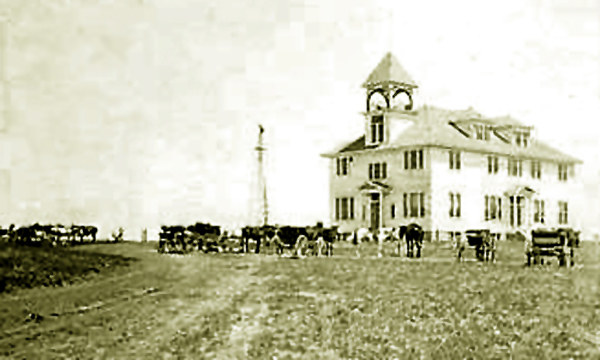
Jireh College, approx. 1910.
The bell in the cupola proved to be too heavy for the structure and was taken down. During
World War II the bell was donated to a scrap metal drive and thus only remains of the college
is the cornerstone next to the right-of-way for the highway.
Dr. Adkinson died in 1933 in Demerest, Habersham County, Georgia, where he was with
Piedmont College.
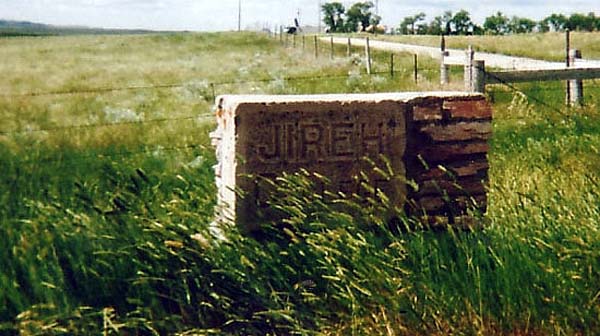
The Remnants of Jireh College, 2005. Photo by Geoff Dobson.
Jireh took its name from the
place where Abraham was about to offer his son up as a sacrifice to Jehovah. See Genesis 22:
|
11. And the angel of the LORD called unto him out of heaven, and said, Abraham, Abraham: and he said, Here am I.
12.
And he said, Lay not thine hand upon the lad, neither do thou any thing unto him: for now I know that thou fearest God, seeing thou hast not withheld thy son, thine only son from me.
13.
And Abraham lifted up his eyes, and looked, and behold behind him a ram caught in a thicket by his horns: and Abraham went and took the ram, and offered him up for a burnt offering in the stead of his son.
14.
And Abraham called the name of that place Jehovah-jireh: as it is said to this day, In the mount of the LORD it shall be seen.
"Jehovah-jireh" means Jehovah will see; that is, Jehovah will provide.
But Jireh is not forgotten. Direh Road still leads south toward Flattop. The community of
Flattop, discussed on the next page itself no longer exists.
South of Lost Springs, Jireh and Keeline also existed an area of dry-farming originally known as the "Dieleman Neighborhood" after
William W. Dieleman (1883-1959). The Dielemans came from Northern Kansas as did many other settlers in the area.
Thus, when a church was constructed by the settlers in 1913, it was decided to name the church after the town
from which they came. Thus, the church as named "Prairie View Church" after Prairie View, Kansas.
With a thousand dollar grant from the Presbyterian Church, the settlers constructed the church themselves, bring the lumber from
sixty miles away. The men bringing the lumber represented five separate denominations.
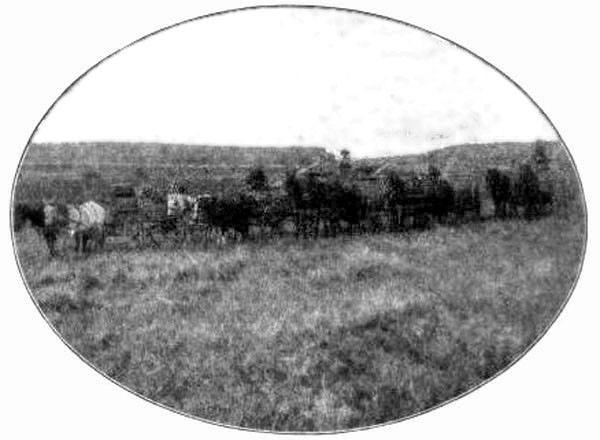
Bringing the lumber to Prairie View, 1913.
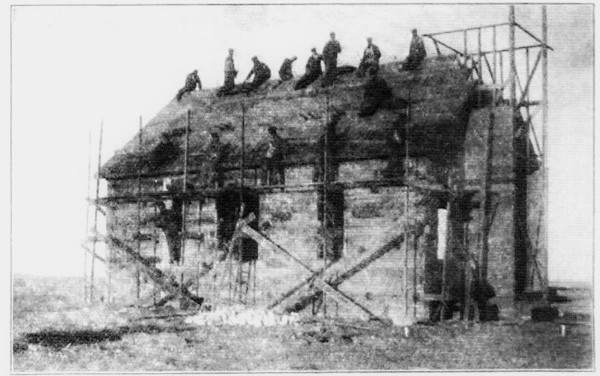
Prairie View Church under construction, March 13, 1914.
The Church was completed by Thanksgiving 1914 and a communal Thanksgiving dinner was held at the
church. Some 76 neighbors attended.
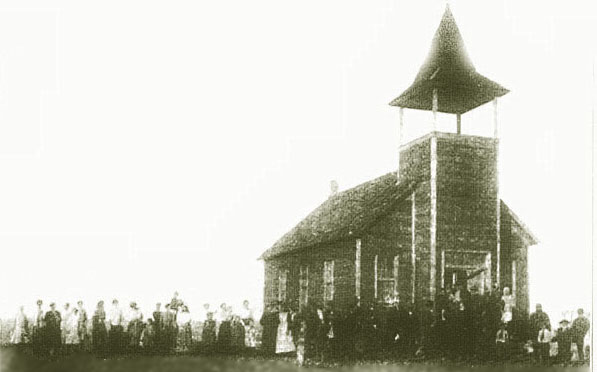
Prairie View Church, Thanksgiving, November 26,1914.
Gradually a small community grew up in the area. The Church was used for community events. A school was construct a short distance away which took on
the Name "Prairie View" and a short distance away a cemetery was started. The only
remnant of the community is the cemetery.
A short distance west of Lost Springs in Converse County is the community of Shawnee. It was originally a center for
coal mining and dry-farming. It too had a bank, hotel, and a newspaper, the short-lived . The Post Office
dating to 1887 closed in 2007. The residents of the area south of Manville, Jireh, Lost Springs, and Shawnee at various times as the various post offices closed down
had their mail delivered from different post offices. Thus they are shown in geneological records as residing in
different places although they never moved.
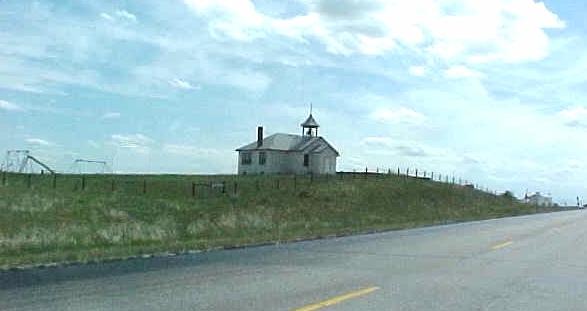
Shawnee School, 2001, photo by Geoff Dobson
Shawnee was originally a shipping point for the Onyon Coal Mine located about
3 1/2 miles to the northeast along an old railroad grade. The Shawnee Coal Co., was a subsidiary of the railroad.
Next Page: The Spanish Diggings.
|